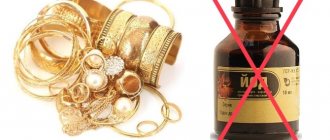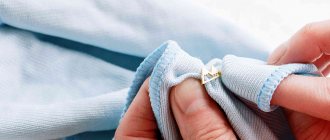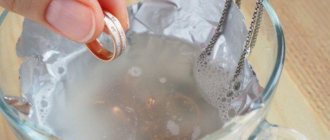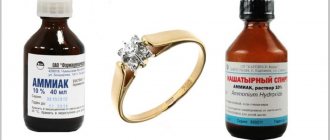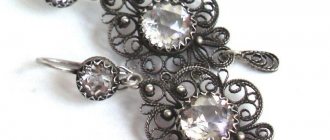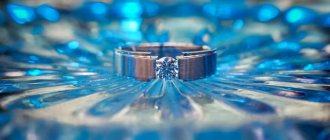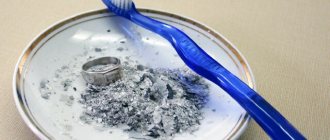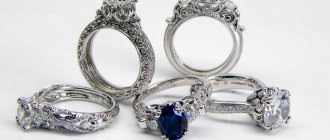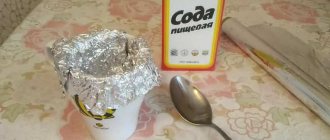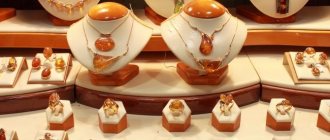How to clean gold with stones: Pixabay How to clean gold with stones to make the jewelry look chic again? A professional can handle the task, but there is an alternative option. If you are interested in cleaning gold jewelry with stones at home, take into account the recommendations of experienced craftsmen.
Why does plaque appear on gold items?
There are 4 reasons for gold contamination:
- There is too little gold in gold. As we said above, even 585 gold contains less than 60% of the noble metal. Samples in the 300-400 range are 30-40% gold respectively. The more impurities, the faster the metal oxidizes.
- The rhodium layer has worn off. Gold itself does not shine very well, so jewelers cover it with a thin layer of rhodium, a noble silver-white platinum group metal. Rhodium protects gold from external influences and gives it shine. The layer is erased - oxidation accelerates. In addition, in places where rhodium has been completely erased, oxidation penetrates deep into the metal, and such stains can no longer be removed.
- The product is constantly exposed to sweat and other skin secretions. The skin constantly produces sweat (which contains salt) and sebum (which contains acids). All this reacts with rhodium and gold, leading to both mechanical contamination and oxidation.
- The product is in contact with air. This factor cannot be ruled out at all. Oxygen, which is part of the air, is an aggressive element, and under its influence, metals oxidize, which is why characteristic stains appear.
There is nothing you can do about the first two reasons - even if you clean off the plaque, it will quickly return. But the problems caused by points 3 and 4 can be solved.
Simple rules of care
Every owner of jewelry made of precious metals dreams that they always look beautiful and shiny. To do this, you need to follow simple rules for preserving gold:
- It is recommended to remove jewelry every time you have to clean the house or go to the bathhouse or sauna. It is recommended to do the same when visiting a fitness club or sports section. Over time, scratches will cause the metal to tarnish and change its appearance.
- Every day at the end of the day you should remove your jewelry and wipe it with a soft cloth.
- They store gold in boxes, protecting it from dust and sunlight, which have a detrimental effect on its beauty and shine.
- It should be taken into account that this metal does not like sudden changes in temperature.
These rules are quite simple, but most people do not adhere to them, which is why they have to clean their jewelry every few months. Special tools are quite expensive, and not everyone will agree to entrust the work to a professional. Therefore, you should know simple methods for cleaning precious metals at home.
Degrees of pollution
Weak
Light contamination is when there is one small or medium-sized stain occupying a small area:
Such stains can be cleaned in an hour or two using available means.
Average
The average degree of contamination is when there are several stains, in total occupying up to half of the product:
In this case, you can still clean the gold yourself, but: a) it will take you a lot of time; b) small spots may remain.
Strong
If the contamination is severe, almost the entire product is covered with stains; it is not possible to determine not only the type of gold, but also the type of metal in general:
Source: nikvesti.com
If you try to clean this jewelry yourself, you will spend a lot of time and will not achieve an ideal result; the stains will still remain. It is better to have such an item professionally cleaned.
Rules for cleaning gold jewelry
What products should you not use water to clean?
Contrary to popular belief, water can be used to clean any jewelry. The only point is to take drinking water from the store; you should not take water from the city water supply - it contains too many impurities.
When is it better to entrust cleaning to a professional?
First of all, if it is heavily soiled, you will not be able to clean such gold on your own. The second case is moderate contamination when it comes to a chain. The fact is that the chain has many corners (even if they are rounded), and when cleaning them at home, a residue will remain in them.
Features of cleaning jewelry made from different types of gold
White gold
White gold is an alloy of gold and other noble, shiny and soft metals (palladium, platinum). The rhodium layer of white gold is quite thick, and if it is removed, the product will quickly lose its shine. Therefore, mainly use chemical cleaning methods, and if you need to use mechanical ones, use a felt cloth, for example.
Red gold
Since red gold contains quite a lot of copper, you need to spend more time soaking to dissolve the plaque in the microcracks - otherwise the stains will return, and they will do so much faster than usual.
Yellow gold
Ordinary gold does not require any special approach.
Gilded
As in the case of white gold, do not use rough mechanical methods (a toothbrush, for example), because there is a chance of removing this very gilding.
Matte gold
Have matte gold cleaned by a professional. The structure of such gold is porous or pitted, and with home methods you will not be able to clean out everything that is stuck in these depressions. At worst, you will damage the surface structure of the matte gold.
Made from medical gold
Medical gold is a durable material, so there are no special features to clean it.
Jewelry with stones
If there is a stone in the jewelry, you need to take this point into account when choosing a cleaning method, since jewelry stones are quite capricious things.
Which stones require special care?
By prohibited methods:
| It is forbidden | Type of stones |
| Heat above 60 degrees | All stones |
| Use non-neutral chemicals, i.e. alkalis or acids | Garnet, aquamarine, tourmaline, turquoise, pearl, amethyst, peridot, opal |
| Apply rough physical force - clean with a brush or pastes containing hard crystals | Garnet, emerald, aquamarine, tourmaline, turquoise, ruby, pearl, amethyst, peridot, opal, topaz |
| Wet, rinse with water | Opal and turquoise |
What can you use for DIY cleaning?
Petrol
Gasoline is an almost ideal cleaning agent. It quickly dissolves both fat and oxides, while it does not cause damage to gold or stones. The only problem is that for a few days after cleaning the jewelry will smell like gasoline, and for another week it will smell slightly.
Alcohol
Alcohol removes grease and ordinary dirt perfectly, but it does not cope very well with dark spots. You can treat the stone with alcohol, and clean the gold itself using other methods.
Care and regular visits to a jeweler to check a piece with a precious stone
To avoid having to boil gold jewelry in the future, risking ruining it, or using other methods at home, you need to follow simple rules:
- before taking a shower or bath, remove all rings and earrings;
- You should not play sports without taking off your jewelry;
- body and hand cream is applied before putting on rings and other jewelry;
- do not visit the bathhouse without removing gold earrings and bracelets, especially if these are inlaid items;
- periodically carry out cleaning with improvised means so as not to damage the products;
- You should not polish jewelry yourself, as this may cause the stone to become loose;
- It is important to store gold items separately; for this purpose, use a box with inner lining;
- Every year they turn to a specialist to prevent the formation of defects: they check for chips, scratches, and the reliability of fastenings.
Preparing for cleaning
First, decide whether you want to clean gold at home yourself. The effect will still not be as high quality as with professional cleaning. If you still decide, prepare everything you need for cleaning (methods and ingredients/tools will be below). Cleaning consists of 3 stages: soaking, mechanical cleaning, polishing. For soaking, you will need a chemically neutral container (plastic or glass); for cleaning and polishing, you will need a table with direct bright lighting.
Popular ways to purify gold at home
Soak
Salt
Saline solution, to be precise. Salt dissolves grease and dirt, making stains more pliable for subsequent mechanical cleaning. What to do:
- We heat the water to 100 degrees.
- Pour 5-6 tablespoons of salt into the dishes.
- Pour boiling water over the salt.
- We are waiting for it to cool to room temperature.
- Place jewelry in this liquid for 12-24 hours.
You need to use fine salt - it dissolves faster and better. When you add water to the salt, stir and see if there is any large sediment. It is highly desirable that it not be present, because large particles of impurities can scratch the product.
Dishwashing liquid
It dissolves grease and dirt well and does not affect dark spots at all. It’s very simple to prepare: take half a glass of warm water, add a couple of drops of detergent, stir, and place gold in this solution. Keep for 3-4 hours, rinse after soaking.
Ammonia and washing powder
This recipe also does not affect stains, but can eliminate any contamination: stubborn dirt, grease, machine oil, and so on. This recipe probably won’t work with fuel oil alone—you’ll need gasoline.
To prepare the mixture, you need to boil water, pour it into a container and add 2 teaspoons of washing powder, then stir it all until the powder dissolves. Now - attention, you need to wait until the entire mixture has cooled to room temperature. When it has cooled down, add a tablespoon of ammonia. If you pour it into hot water, it will evaporate quickly. Pour in, stir, place the decorations in the container for 3-4 hours. Afterwards we wash it.
Liquid soap and hydrogen peroxide
Excellent for removing fat and blood. We do the same with soap as with washing powder in the previous recipe: boil water, pour it into a container, add soap, stir until dissolved. Now pour 2-3 tablespoons of peroxide and place the gold in the container. Keep for 2-3 hours. After soaking, you need to rinse.
Lemon acid
Citric acid is weak enough not to harm the product, but strong enough to dissolve fat. To prepare the solution, you need to take a quarter spoon of acid, dissolve it in 100 ml of hot water, let it cool slightly, and place the jewelry in the solution for 10 minutes. After this, be sure to rinse.
Peroxide and ammonia
Eliminates blood and chemical contamination. There is no soaking as such here, because you need to take a cotton swab, drop 2-3 drops of alcohol and peroxide on it, and wipe the product with the swab. Ineffective for chains, use this option with rings and earrings.
Mechanical cleaning
It is better to carry out mechanical cleaning with a rag; a toothbrush is for completely hopeless cases. Make a cleaning suspension, blot the rags a little, and clean.
Toothpaste and Vaseline
Toothpaste cleans both stains and dirt well, but there is a problem - it consists of small sharp crystals that can remove the top layer from the product. To prevent this scenario, toothpaste is mixed with Vaseline in a 1:1 ratio.
Chalk and laundry soap
But this recipe is used for tough cleaning. The chalk is crumbled, the head of the toothbrush is rubbed with laundry soap, chalk crumbs are sprinkled on top and cleaned. Only suitable for low grade items with large stains.
Chalk and ammonia
Similar to the previous recipe, but even tougher. The chalk needs to be crushed and mixed with ammonia until you get a thick mass. Then this mass should be applied to a toothbrush and the product should be cleaned.
Polishing with improvised materials
Velvet or felt cloth
We take a cloth, take the product, polish it. It will take a long time to polish, but you will get a shine and won’t damage anything.
Eraser
Before polishing the product with a velvet or felt cloth, you can go over it with an eraser if not all the fat was removed by soaking. Using just an eraser is ineffective.
Vinegar
Drop vinegar onto a cotton pad and polish. This method is best used regularly, from time to time - it removes the fat that causes the jewelry to fade.
Vinegar and soda
Slaked soda removes remaining dirt - the released hydrogen literally lifts the dirt off the jewelry. Take a cotton pad, sprinkle it with baking soda, drop a couple of drops of vinegar until the soda sizzles - wipe the product, then repeat.
Paste GOI
GOI paste is a special polishing paste developed in the USSR. You can’t make it yourself - you need to buy it. There are 4 types of paste, numbered 1, 2, 3 and 4. The higher the number, the larger the particles from which it consists. You should be interested in pastes numbered 1 and 2, pastes 3 and 4 are too large (meaning particle size), you will scratch the outer layer. It’s very easy to use; we buy the paste, apply it to a cotton pad, and polish it.
Store-bought cleaning products
"Aladdin"
A cheap and effective cleaner for cleaning gold, platinum and palladium items. It copes with dark spots so-so, but with the rest it works great. There are two variations: solution and napkins. Ingredients: water, ammonia, a mixture of detergents, Trilon B. Cannot be used for jewelry with stones. A jar of solution costs about 200 rubles, a set of napkins costs about 100 rubles.
Solution
The jar has a special basket and brush. We put the gold jewelry in the basket, immerse the basket in the jar for 5-7 minutes, take it out, and if necessary, clean it with a brush. We rinse.
Napkins
We take a napkin, wipe the product, remove all the dirt - rinse it.
Connoisseurs
Set “solution + napkins”. Place the decoration in the solution for 5 minutes, clean it with a brush (included in the kit), and wipe it with a napkin. The product costs 900 rubles per set.
HAGERTY GOLD CLEAN
Another cleaning liquid. It differs from the previous ones in 3 points:
- You need to soak the decoration for 2 minutes, not 5.
- Costs 1,800 rubles per jar.
- Napkins need to be purchased separately.
What other products can be used for cleaning?
We do not recommend using any methods other than those described above. At best they will be useless, at worst you may encounter a high-hardness abrasive material and severely scratch the surface of the gold, causing the shine to disappear completely.
How not to clean gold
In various sources you can find many strange or downright harmful cleaning methods for the product. Here are the most controversial ones:
- Sugar . It is suggested to be used when soaking. Why is it completely unclear; sugar will not restore shine and will not remove dirt.
- Dentifrice. Suggested for use during mechanical cleaning and/or polishing. Don’t even try - you’ll wipe off the outer layer; tooth powder has high hardness and a large diameter of crystals.
- Lipstick. Usually this means hygienic, although some sources do not even indicate this. There is no point in using it - lipstick consists of fat, which we, on the contrary, are trying to remove from jewelry.
- Soda . Soda dissolved in water in most concentrations is PH-neutral, that is, it will not remove dirt. It also cannot be used for polishing and mechanical cleaning - you will scratch the outer layer.
- Beer and apple juice . And also honey, eggs, onions and other useless or harmful (as in the case of honey) methods. Perhaps the authors of these methods have not been fed for a long time.
How to clean white gold
jewelerymag.ru
White gold differs from ordinary gold in that silver, palladium or nickel are added to it to obtain a light shade, and the top is often plated with rhodium. It protects the jewelry and gives it a white shine.
Harsh methods are not suitable for such products, but the following will be useful:
- Ammonia + hydrogen peroxide . Mix both liquids in a container in a ratio of 1:2. Place the gold in the resulting solution for half an hour, and then rinse in running water and wipe dry with a towel.
- Sugar . Dissolve 2 tablespoons of sugar in a glass of water. Soak the jewelry in the sweet solution for 10–12 hours: this will restore their former shine.

